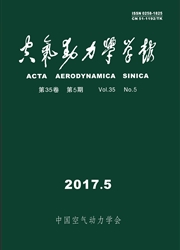

 中文摘要:
中文摘要:
应用理论方法和数值模拟方法开展升浮一体太阳能无人机气动布局设计研究,通过优化选形设计获得高升阻比气动布局,对比两种方法的计算结果以及分析存在差别的原因;应用张线天平支撑风洞试验测试技术,对设计布局开展实验验证研究,建立大展弦比的双机身气动布局风洞试验测试方法,分析了不同雷诺数下实验模型的纵向和横向气动特性影响。研究结果表明:风洞试验结果与设计结果吻合良好,验证了设计结果的可靠性,获得了对总体设计具有指导意义的结论和试验数据结果。
 英文摘要:
英文摘要:
The aerodynamic configurations of a solar powered buoyancy-lifting vehicle in the near-space were investigated using both engineering method and Computational fluid dynamics. The optimized aerodynamic configurations with high lift to drag ratio were obtained by optimiza- tion design method respectively, and the differences between two cofigurations from the two methods were analyzed. Experiment study on the aerodynamics configuration was done by cable mounting wind tunnel testing technology, and testing methods in wind tune experiment of high aspect ratio with two fuselages configuration were developed. Aerodynamic performance of the test model in pitching and lateral were analyzed in different Reynolds number. Conclusion of this investigation showed that wind tunnel experiment results and computational results were according well one another and the configuration design methods were validated, experiment results could give technology support to solar powered buoyancy-lifting vehicle system overall design as well.
 同期刊论文项目
同期刊论文项目
 同项目期刊论文
同项目期刊论文
 期刊信息
期刊信息
